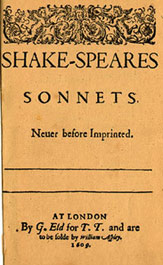
Originated by Giacomo de Lentino in the 13th century, the sonnet is the most universally known poetic form in the English language.
Although it was already well-practiced in Italy and England, the sonnet vaulted into the literary stratosphere when it became the vehicle of choice for William Shakespeare in his plays and poetic works. Perhaps Shakespeare was not the best sonnet writer, nor the most creative, but he was to poetry what Walt Disney was to animation. Shakespeare’s sonnets (154 of which have survived to this day) expanded opportunities for poets, academics, and students to bring poetry and drama more deeply into their lives.

Shakespeare’s sonnets expanded opportunities for poets, academics, and students to bring poetry and drama more deeply into their lives.
| Rhyme: | Varied, but the two most popular are ababcdcd-efefgg (Shakespearean) and abbaabba-cdcdcd (Miltonic) |
| Structure: | Varied, but most popular is 14 lines, 10 syllables per line, in either two quatrains and two tercets; or three quatrains and a closing couplet |
| Measure/Beat: | Iambic pentameter |
| Common Themes: | Romantic, joys and perils of love |
| Other Notes: |
|
